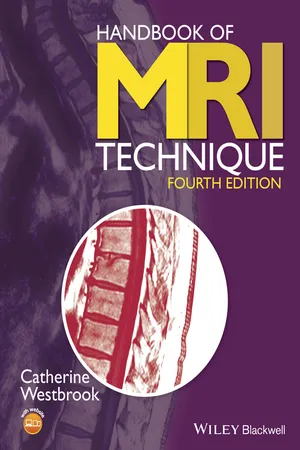
- English
- ePUB (mobile friendly)
- Available on iOS & Android
Handbook of MRI Technique
About this book
Now entering its fourth edition, the market-leading Handbook of MRI Technique has been fully revised and updated to incorporate new technologies and developments essential to good practice. Written specifically for technologists and highly illustrated, it guides the uninitiated through scanning techniques and helps more experienced technologists to improve image quality.
The first part of the book considers the main aspects of theory that relate to scanning and also includes practical tips on gating, equipment use, patient care and safety, and information on contrast media. The second half provides step-by-step instruction for examining each anatomical area, beginning with a basic anatomy section followed by sections on indications, patient positioning, equipment, artefacts and tips on optimizing image quality.
- Written by an international team of technologists from the United States, United Kingdom and Europe
- Suitable for users for all types of MRI systems
- Now includes key points throughout for quick reference
- Companion website at www.wiley.com/go/westbrook/mritechnique with self-assessment and image flashcards
Handbook of MRI Technique continues to be the ideal support both for radiographers new to MRI and for regular users looking for information on alternative techniques and suggestions on protocol modifications.
Frequently asked questions
- Essential is ideal for learners and professionals who enjoy exploring a wide range of subjects. Access the Essential Library with 800,000+ trusted titles and best-sellers across business, personal growth, and the humanities. Includes unlimited reading time and Standard Read Aloud voice.
- Complete: Perfect for advanced learners and researchers needing full, unrestricted access. Unlock 1.4M+ books across hundreds of subjects, including academic and specialized titles. The Complete Plan also includes advanced features like Premium Read Aloud and Research Assistant.
Please note we cannot support devices running on iOS 13 and Android 7 or earlier. Learn more about using the app.
Information
1
How to use this book
Introduction
- parameters and trade-offs
- pulse sequences
- flow phenomena and artefacts
- gating and respiratory compensation (RC) techniques
- patient care and safety
- contrast agents.
- head and neck
- spine
- chest
- abdomen
- pelvis
- upper limb
- lower limb.
- basic anatomy
- common indications
- equipment
- patient positioning
- suggested protocol
- image optimization
- patient considerations
- contrast usage.
Basic anatomy
Common indications
Equipment
- Volume coils that both transmit and receive radio-frequency (RF) pulses and are specifically called transceivers. Most of these coils are quadrature coils, which means that they use two pairs of coils to transmit and receive signal, so improving the signal to noise ratio (SNR). They have the advantages of encompassing large areas of anatomy and yielding a uniform signal across the whole field of view (FOV). The body coil is an example of this type of coil.
- Linear phased array coils consist of multiple coils and receivers. The signal from the receiver of each coil is combined to f...
Table of contents
- Cover
- Title page
- Copyright page
- Preface
- Contributors
- 1 How to use this book
- Part 1: Theoretical and practical concepts
- Part 2: Examination areas
- Index
- Access to companion website
- End User License Agreement